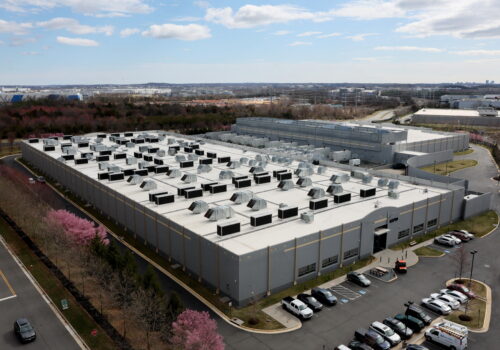Reading between the lines of the dueling US and Chinese AI action plans
Action speaks louder than words—but words are a good place to start. On July 23, the Trump administration released ”Winning the AI Race: America’s AI Action Plan.” Three days later, China unveiled its “Global AI Governance Action Plan.” Both superpowers are in a contest to acquire the best technology and establish the rules of the road for artificial intelligence (AI), and their decisions will have a major impact on the global AI ecosystem. To figure out what these dueling plans mean for both countries and the wider world, we reached out to our top tech minds for their take on six burning questions.
1. The US and Chinese plans are both focused on “AI action,” but are they similar?
Though differing in scope and intent, the AI action plans released by the United States and China targeted the same global audience and provided revealing indicators of how each country aims to define global leadership amid rapid technological change.
The US AI Action Plan is broad in scope, ranging from domestic industrial capacity to promoting US technology abroad. Preceded by President Donald Trump’s visit to Pittsburgh where he touted investments in AI infrastructure, the rollout of the action plan included primarily US industry leaders and policymakers. The plan has three pillars, including accelerating AI innovation, building AI infrastructure in the United States, and international diplomacy focused on US exports, standards, and security.
China’s plan, announced at the World AI Conference in Shanghai, is more narrowly focused on international governance, standards, and norms. Speaking to an international conference on July 26 in Shanghai, Chinese Premier Li Qiang announced thirteen elements of China’s approach to “multilateral and bilateral cooperation.” While the language espouses collaboration, China’s global approach is to ultimately replace the current rules-based, multistakeholder international order with an alternative centered on state control, increasingly through technology.
The proximity of the announcements is no coincidence. But the United States and China are far from the only countries shaping the age of AI.
—Graham Brookie is the Atlantic Council’s vice president for technology programs and strategy.
2. How should we expect each plan to materialize around the world?
China and the United States are advancing fundamentally different visions of AI’s role in the world. For China, AI is geopolitical infrastructure—centralized, sovereign, and aligned with its Belt and Road–style diplomacy. It emphasizes sovereign compute power, data control, and state-led development. The United States, by contrast, sees AI as an economic engine and a pillar of national security, anchored in open innovation, private enterprise, and alliances among democracies.
This divide cuts deeper than policy. China champions state control using the term “sovereignty,” while engaging in multilateral fora and United Nations (UN)–led mechanisms to bend the rules-based international order toward its state control model and steer global AI governance, positioning itself as a voice for the Global South. The United States clings to industry and a market-driven agenda, promoting “trusted” governance through broad Organisation for Economic Co-operation and Development (OECD) principles and the narrower Group of Seven (G7) partnership—while tightening export controls and tech restrictions. While China leverages AI diplomacy through infrastructure, training, and open-source tools, the United States doubles down on norms and safeguards.
This is about more than just technology—it’s a battle between rival digital worldviews. One champions state control and sovereign authority; the other bets on openness, markets, and liberal norms. As the Global South navigates between these competing visions, the outcome may not be a clean split—but a fractured landscape is inevitable. The coming decade will hinge on which model proves more persuasive, more scalable, and more aligned with global aspirations.
—Konstantinos Komaitis is a resident senior fellow and global governance and technology lead at the Atlantic Council’s Democracy and Tech Initiative.
3. How do the competing plans impact the AI tech stack and global infrastructure?
The United States and China are offering starkly contrasting visions for global AI governance. The US plan emphasizes strategic competition with China and prioritizes maintaining US technological primacy. It advances an ambitious—and, some would say, aggressive—framework: bolstering enforcement of existing chip export controls, pressuring allies to align with US restrictions under threat of penalty, and generally seeking to create dependencies on US technology products, including by providing an all-in-one AI tech stack as part of its foreign policy strategy. When partners are mentioned, it is with a somewhat antagonistic tone—they are described largely as either potential customers or as obstacles to be brought into compliance. The plan outlines the need to counter China in international governance bodies—which is a good and welcome inclusion—but with multiple State Department agencies facing deep staffing cuts, including many with deep knowledge of and relationships in these fora, it is difficult to see how the United States will effectively navigate these diplomatically nuanced and complex processes in a way that furthers US interests.
This haphazard approach stands in stark contrast to the People’s Republic of China’s (PRC’s) engagement on AI governance. The PRC’s announcement builds on a years-long, multi-pronged, interlocking, and self-referential strategy designed to ensure China’s dominance in AI governance. The thirteen-point plan—which emphasizes themes of multilateralism, inclusivity, and deep engagement with Global Majority countries on their terms—builds on the PRC’s quiet and consistent work to build coalitions of Global Majority countries to vote in its favor in the very UN bodies mentioned in the US AI plan, including the Global Digital Compact. Crucially, promotion of China’s tech stack is part of this broader diplomatic engagement strategy. For example, Huawei offers long-standing “AI in a Box” solutions for governments seeking such technologies. These kinds of all-in-one offerings are often paired with financial incentives (for both the Chinese company and the recipient government), as well as follow-up training modules that promote Chinese initiatives and approaches to technology governance.
The US AI Action Plan appears to be competing with China on the basis of offering a superior all-in-one AI tech stack. It is encouraging that the United States is finally recognizing this cornerstone of China’s strategy. However, Washington is failing to recognize a key source of China’s success—and one that may ultimately determine its own failure: the mutually reinforcing relationship between technology and diplomacy, executed in a systematic, nuanced, and consistent manner.
—Kenton Thibaut is a senior resident China fellow at the Atlantic Council’s Digital Forensic Research Lab (DFRLab).
4. Do the two plans allow room for cooperation?
There’s no doubt that Washington and Beijing view each other as rivals, including in the artificial intelligence race. But both sides also share overlapping interests that could—and, at this moment of heightened geopolitical tensions, it remains a “could”—offer a path forward toward cooperation on the inner-workings of this emerging technology where both sides could benefit from some form of détente.
The United States and China both highlighted the need for all parts of society to benefit from a technology that will likely seep into every part of individuals’ daily lives in the years to come. That may be a small point. But Washington and Beijing both committed to making AI as accessible as possible, including across several non-tech-related industries. That’s a commitment that may open the path for the geopolitical rivals to work on common apolitical standards, as they did in 2023 when signing the voluntary Bletchley Park Declaration around AI safety.
Both sides also made pledges to improve the wholesale datasets that underpin the latest large language models. That won’t involve the United States and China sharing sensitive information between each other. But it could potentially offer ways to build mutually accessible datasets in topics like public health and biotechnology in ways that already exist between the two countries.
Washington and China made separate commitments around energy infrastructure to fast-track AI development. Again, these efforts will be done in silos. But some of this infrastructure, including the upgrading of national energy grids to meet the demands of reams of new data centers, could also benefit from lessons learned—and experiences shared—between the two geopolitical rivals.
—Mark Scott is a senior resident fellow at the Democracy and Tech Initiative.
5. How will Global Majority countries interact with these competing plans?
China’s plan portrays AI as a driving force for economic and social development. Its statement at the World AI Conference (WAIC) emphasized how AI could help to achieve the UN 2030 Agenda for Sustainable Development. It is a strategic play, as shared benefits and sustainable development are particularly crucial on China’s engagement with African countries and the broader Global Majority.
In contrast, the US plan takes a competitive approach with the goal of market dominance. While this aim of maintaining technological leadership may be legitimate, Global Majority countries could view it as confrontational. These nations may hesitate to increase their technological dependence on a global power perceived as unwilling to consider their development needs.
China’s plan is in line with its longstanding foreign policy principles, as evidenced in United Nations debates over the years. Together with the group of developing nations known as the G77, China has maintained that global governance mechanisms should prioritize and be more responsive to the diverse needs and developmental stages of countries, particularly those in the developing world. Its WAIC statement emphasizing national sovereignty as a fundamental aspect of AI governance aligns with China’s goals of increasing state control at both the national and international levels.
China’s WAIC statement also proposes exploring a global mechanism for data sharing and promoting the “orderly and free flow of data” while maintaining security. Ensuring that data flows are “secure” or “safe” is a common theme in China’s data policy, often indicating a desire to keep data under state control. Such provisions may align well with the demands for data governance sovereignty relevant to countries in Africa or the BRICS group of emerging economies. Nonetheless, African and Latin American digital rights organizations are often critical of their countries adopting Chinese-influenced data governance frameworks, since they are aware of the risks of surveillance and digital repression enabled by government control of citizens’ data.
Overall, China’s strategy could further strengthen the support of G77 countries for a state-centered global AI governance model, ultimately advancing Beijing’s geopolitical interests. The United States must address the needs and desires of Global Majority countries if it aims to export its AI stack to those nations and outcompete China.
—Iria Puyosa is a senior research fellow at the Democracy and Tech Initiative.
6. What can we expect next from China and the US on international AI governance?
The rapid proliferation of AI has led to an “adopt or risk obsolescence” mindset, with many governments, Beijing at the forefront, turning to internal balancing strategies focused on bolstering sovereign capacity to develop and use AI. China’s plan reflects a gradual shift in approach, as Beijing realizes its own growth depends on networked forms of power.
In contrast, the dominance-based approach of the White House plan underestimates the value the United States has historically derived from its agenda-setting power in international governance. This is not just the power to influence what is discussed in international forums, but also what never gets to the table. Meanwhile, Beijing has proposed setting up a new Shanghai-based World AI Cooperation Organization and cooperative processes for AI development and governance under the UN’s Pact for the Future and Global Digital Compact.
Beijing, it appears, is taking a page from a US playbook it has long criticized. Internet governance observers will remember that through the 2000s, Brazil, Russia, India, China, and South Africa opposed the Internet Corporation for Assigned Names and Numbers’s (ICANN’s) role in internet governance over concerns of US control. It may not be long before China rolls out an ICANN for AI. And the world may react quite differently.
—Trisha Ray is an associate director and resident fellow at the Atlantic Council’s GeoTech Center.
Further reading
Wed, Jul 23, 2025
Experts react: What Trump’s new AI Action Plan means for tech, energy, the economy, and more
Experts react By
Our experts unpack how the Trump administration’s AI Action Plan will impact the US tech industry, energy policy, and global AI governance.
Mon, Jul 21, 2025
Navigating the new reality of international AI policy
GeoTech Cues By Evi Fuelle, Courtney Lang
To reach their goals of national AI adoption, governments must continue to advance the global policy discussion on trust, safety, and evaluations.
Wed, Jul 2, 2025
To avoid an AI data-center bubble, Washington must change how it works with US states
New Atlanticist By Trisha Ray
Without better state-federal coordination, the United States risks sinking billions into stranded capacity, with taxpayers footing the bill.
Image: US President Donald Trump delivers remarks on artificial intelligence at the "Winning the AI Race" Summit in Washington D.C., U.S., July 23, 2025. REUTERS/Kent Nishimura



